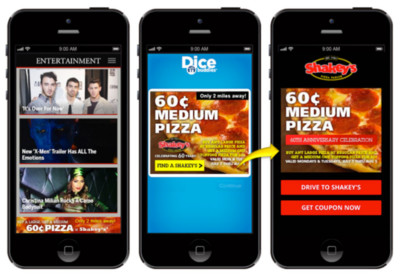If you’ve been advertising online for any amount of time, you’re probably already pretty familiar with a couple of the most common ways to run ads on the web.
There’s paid search of course. Ad people call that “search engine marketing” (abbreviated SEM because we love abbreviations). This is where you basically pay for a set of search terms so that your text ad pops up at or near the top of a search engine query.
Then there’s display advertising where, based on a set of target parameters, your image ads get served to a specific audience.
Both of these options let your customers click through to your website, so that’s cool. But as is often the case with the internet, new technologies are always being developed to make your digital spend more effective. Two recent developments in digital ad tech are leading the way to help you find and engage your customers, responsive ads and dynamic ads. So, what are they and how do they help your business? In this installment of our plain-talk digital series, we’ll break it down for you.
What are responsive/dynamic digital ads?
- Both dynamic and responsive ads are forms of digital ads (display, content, social or paid search ads) that automatically adjust the ad depending on a set of parameters you choose.
- The parameters can be set based on what the platform you’re using knows about the digital user to offer a more personalized and relevant experience that delivers better results for your business. So, what’s the difference?
Responsive ads:
- Responsive ads are characterized by their ability to “fit” effectively on the device and internet site the potential customer is on. Much like how websites must be designed to be “responsive” for different devices today, so too must ads. Responsive ads also adjust for different website ad inventory sizes.
Dynamic ads:
- Dynamic ads adjust to a different set of parameters than responsive ads. For dynamic ads, the parameters are more about how people behave online. This may come as a shock to you, but when people are online, platforms are collecting tons of data about them! OK, not really shocking, but it’s this data feed that informs dynamic ads. Depending on the data feed, dynamic ads can change the content that they serve to your customer.
- For example, maybe a customer is surfing the web and meets the basic criteria for being served a pet food ad from a company like Purina One. Depending on the customer’s online behavior, he may have identified himself as a cat owner or dog lover. With dynamic ads, the content would populate (cat or dog) based on that data. Maybe he’s further defined himself as a Labrador Retriever fan— boom! Now the dog in your ad is a Lab instead of a Schnauzer. By creating dynamic ad creative options that work for the data-feed options available, you increase the likelihood of that first click to engagement. And of course, dynamic website content can make sure that data is expressed on your website as well. Setting up dynamic ad content requires some planning of course, but the potential benefits are significant.
- So essentially, dynamic and responsive ads can offer a more personalized, relevant experience for the user and can generate better results for the advertiser. A recent Google Communities chat had a great pizza analogy for responsive and dynamic ads. To paraphrase, responsive ads are the pizza dough. It can be made to fit any sized pan. Dynamic ads are the pizza toppings, the things that let you customize the pizza to what you’re craving at the moment based on your data feed.
And then there’s remarketing
- Speaking of pizza, what if we established online that your customers want pizza but haven’t bought pizza yet? Well we could just follow them around the internet and serve them more ads about that perfect pizza they’re noodling. That’s remarketing. Dynamic ads are excellent for remarketing because content and offers can be served and tweaked across multiple platforms and devices to entice customers until (in this case) the pizza company makes the ad that resonates best with the hungry customer like in this great sequence from Shakey’s Pizza.
So, what does this mean for you?
By having your agency create dynamic and responsive ads with remarketing you can:
- Save money – using these ads which automatically adjust size and content based on your parameters means your agency won’t have to conduct endless “versioning” of ads to meet the dozens of ad size requirements each vendor may have for you to run ads on their network. Rather than versioning, we just upload a series of assets (images, text options, headline options) and let the platform do the work for us. While saving money, this method also eliminates some guesswork by automatically optimizing towards the best performing creative for each target user group.
- Grow effectiveness – PriceWeber and other agencies consistently see greater levels of click-through and purchase when using the one-two-three punch of dynamic and responsive ads with remarketing. This is why you advertise in the first place, right?
- Grow efficiency – By running smarter, more effective ads, your ad spend will go farther and deliver results more efficiently, ultimately lowering your cost per acquisition.
Responsive and dynamic ads on Google
As mentioned earlier, if you’ve advertised online at all, you’re probably spending money on paid search on Google. What you may not have noticed is that Google has two (fairly) new options for search ads, dynamic search ads and responsive search ads:
Google dynamic search ads
- These ads use your website to target your ads and can help fill in the gaps of your keywords-based campaigns. This ensures you don’t miss relevant searches, experience delays in writing ads for new products, etc.
- When someone searches on Google with words/phrases related to titles/phrases found on your website, Google will automatically use these titles/phrases to generate an ad and select a relevant landing page to link to.
- Targeting is based on content from a website – you can target by landing pages from current ad groups, set categories of landing pages organized by theme, or use a page feed to target select URLs.
Google Responsive Search Ads
- These ads are created based on a series of assets uploaded into Google. Instead of writing headlines and descriptions together to create a single text ad, with responsive ads you can write up to 15 different headlines and 4 different descriptions, which gives Google over 43K options to create a customized ad for the user.
- Over time, Google will serve the best message to different searchers depending on the keyword they search for, device, browsing history, etc.
- You can also lock certain aspects into place which may limit some of the combinations Google produces but can protect some of your content (i.e., maybe you always want your brand name listed first but are okay with the other headlines being swapped as needed.)
- Ads will show up to 3 headlines and 2 descriptions but adjust based on the user’s screen size and the page’s content.
Need more information on driving business using responsive and dynamic ads?
Have any questions about how to drive more relevant leads to your site? Drop us a note or give us a call at 502-499-4209.
Legal stuff: Purina and Shakey’s Pizza are registered trademarks of their respective parent companies. No delicious pizzas were harmed in the writing of this e-newsletter.



